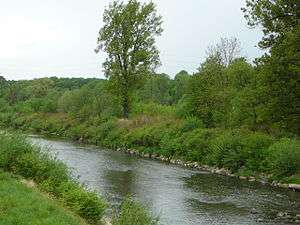Olza (river)
| Olza | |
|---|---|
 Olza River as seen from the bridge connecting Český Těšín and Cieszyn during winter. | |
| Country | Poland, Czech Republic |
| Basin | |
| Main source | Silesian Beskids, Cieszyn Silesia |
| River mouth | Oder River |
| Basin size | 1,118 km2 (432 sq mi) (639 km2 or 247 sq mi in Czech Republic, 479 km2 or 185 sq mi in Poland)[1] |
| Physical characteristics | |
| Length | 99 km (62 mi) (16 km or 9.9 mi in Poland, 83 km or 52 mi in the Czech Republic)[1] (some sources state 86.2 km or 53.6 mi)[2][3][4][5] |
| Discharge |
|
![]() Olza (Czech: Olše, German: Olsa) is a river in Poland and the Czech Republic, the right tributary of the Oder River. It flows from the Silesian Beskids through southern Cieszyn Silesia in Poland and Frýdek-Místek and Karviná districts of the Czech Republic, often forming the border with Poland. It flows into the Oder River north of Bohumín. The Olza-Oder confluence also forms a border.
Olza (Czech: Olše, German: Olsa) is a river in Poland and the Czech Republic, the right tributary of the Oder River. It flows from the Silesian Beskids through southern Cieszyn Silesia in Poland and Frýdek-Místek and Karviná districts of the Czech Republic, often forming the border with Poland. It flows into the Oder River north of Bohumín. The Olza-Oder confluence also forms a border.
It is a symbol of the Zaolzie (Polish: Trans-Olza River) region, which lies on its west bank, constituting a part of the western half of Cieszyn Silesia. The unofficial anthem of this region and local Poles, Płyniesz Olzo po dolinie (You flow Olza, down the valley), written by Jan Kubisz, is centered on the river.
Olza inspired many other artists. Writers who wrote about the river include Adolf Fierla, Pola Gojawiczyńska, Emanuel Grim, Julian Przyboś, Vladislav Vančura, Adam Wawrosz. Singer Jaromír Nohavica used the motive of Olza in several of his songs.
Name
The first historical mention dates back to 1290, when the river is mentioned as Olza.[6] The river was then mentioned in a written document in 1611 as Oldza.[7] At the end of the 19th century, together with the rise of mass nationalism both Polish and Czech activists claimed the name Olza is too little Polish and Czech, respectively.[8] Some Polish activists proposed the name Olsza, Czech activists Olše. Czech linguist and writer Vincenc Prasek found out in 1900 that the name Olza is not Polish, nor Czech but has Old Slavic origin.[7] This revelation was confirmed by various etymological studies in the 20th century.[8] The form Olza used on this territory is derived from the ancient Oldza. German Olsa is derived from Olza. Local people always used the Olza form, regardless of their national or ethnic origin.[7] Even the Germanized form Olsa reads as Olza. However, central administration in Prague saw Olza as a Polish name and when most of the river became a part of Czechoslovakia in 1920 it tried to change its name to the Czech form of Olše. However, till the 1960s still some dualism in the naming existed which was eventually suppressed by the Central State Administration of Geodesy and Cartography.[7][9] Since then, the only official form in the Czech Republic is Olše, however locals from both sides of the border, from both nationalities, still call it Olza.
Towns and villages on the river
(from source to the mouth)
Gallery
 Olza in Bukovec
Olza in Bukovec Olza in Hrádek
Olza in Hrádek Olza in Karviná
Olza in Karviná Olza in Věřňovice
Olza in Věřňovice
Footnotes
- 1 2 3 Cicha et al. 2000, 18.
- ↑ 16 km or 9.9 mi in Poland, 46 km or 29 mi in the Czech Republic, 24 km or 15 mi border between Poland and the Czech Republic
- ↑ Universum. Všeobecná encyklopedie 2001, vol. 6, 624.
- ↑ Słownik geograficzno-krajoznawczy Polski 2000, 532.
- ↑ Nowa Encyklopedia Powszechna PWN 2004, vol. VI, 164.
- ↑ Mieszko, Duke of Cieszyn then wrote: ...dictorum mansorum super fluvium Olzam libere possideat...
- 1 2 3 4 Cicha et al. 2000, 21.
- 1 2 Gawrecki 1993, 13.
- ↑ Gawrecki 1993, 15.
References
| Wikimedia Commons has media related to Olza. |
- Cicha, Irena; Jaworski, Kazimierz; Ondraszek, Bronisław; Stalmach, Barbara; Stalmach, Jan (2000). Olza od pramene po ujście. Český Těšín: Region Silesia. ISBN 80-238-6081-X.
- Gawrecki, Dan (1993). "Olza a Olše". Těšínsko. 36 (2): 13–15.
- "Olše". Universum, Všeobecná encyklopedie. VI. Praha: Odeon. 2001. ISBN 80-207-1060-4.
Coordinates: 49°56′55″N 18°20′0″E / 49.94861°N 18.33333°E


